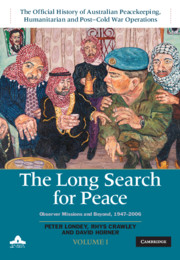Book contents
- The Long Search for Peace
- The Official History of Australian Peacekeeping, Humanitarian and Post–Cold War Operations
- The Long Search for Peace
- Copyright page
- Contents
- Maps
- Preface
- Glossary
- Part 1 Actor and observer
- 1 The origins of peacekeeping
- 2 St George and the maiden
- 3 Inventing peacekeeping
- 4 Failure
- 5 Success
- 6 Observing at a critical moment
- 7 An intractable dispute
- 8 ‘Tough men wanted’
- 9 Australia and the problem of Palestine
- 10 The Six Day War and after
- 11 ‘If you’re not confused, you don’t understand the situation’
- 12 Over jungle and swamp
- 13 A reluctant start
- 14 The first decade
- 15 Australia and the invention of peacekeeping
- Part 2 New ambitions
- Part 3 Carrying on
- Conclusion
- Book part
- Bibliography
- Index
- Plate Section (PDF Only)
3 - Inventing peacekeeping
The United Nations in Indonesia, 1947–48
from Part 1 - Actor and observer
Published online by Cambridge University Press: 27 September 2019
- The Long Search for Peace
- The Official History of Australian Peacekeeping, Humanitarian and Post–Cold War Operations
- The Long Search for Peace
- Copyright page
- Contents
- Maps
- Preface
- Glossary
- Part 1 Actor and observer
- 1 The origins of peacekeeping
- 2 St George and the maiden
- 3 Inventing peacekeeping
- 4 Failure
- 5 Success
- 6 Observing at a critical moment
- 7 An intractable dispute
- 8 ‘Tough men wanted’
- 9 Australia and the problem of Palestine
- 10 The Six Day War and after
- 11 ‘If you’re not confused, you don’t understand the situation’
- 12 Over jungle and swamp
- 13 A reluctant start
- 14 The first decade
- 15 Australia and the invention of peacekeeping
- Part 2 New ambitions
- Part 3 Carrying on
- Conclusion
- Book part
- Bibliography
- Index
- Plate Section (PDF Only)
Summary
The Security Council resolutions of 25 August 1947 had set up (or at least foreshadowed) two UN bodies to assist with the Indonesian problem. Most immediately, noting that the Indonesian Republic had requested ‘a commission of observers’, the Council asked the countries that had ‘career consular representatives’ in Batavia to instruct themto prepare jointly for the information and guidance of the Security Council reports on the situation in the Republic of Indonesia following the resolution of the Council of 1 August 1947, such reports to cover the observance of the cease-fire orders and the conditions prevailing in areas under military occupation or from which armed forces now in occupation may be withdrawn by agreement between the parties. This group of consuls, representing Australia, Belgium, China, France, the United Kingdom and the United States, came to be known collectively as the Consular Commission. Their task was an immediate one: to report to the Council on the situation, and was to begin immediately.
- Type
- Chapter
- Information
- The Long Search for PeaceObserver Missions and Beyond, 1947–2006, pp. 57 - 94Publisher: Cambridge University PressPrint publication year: 2019



